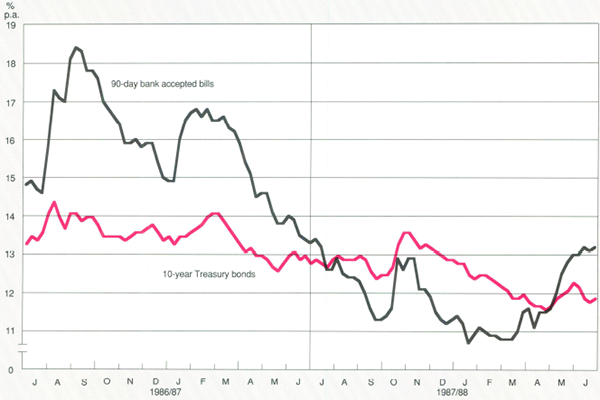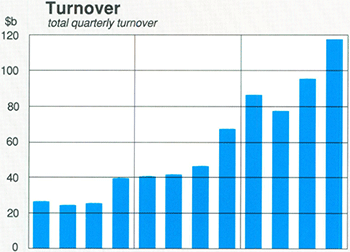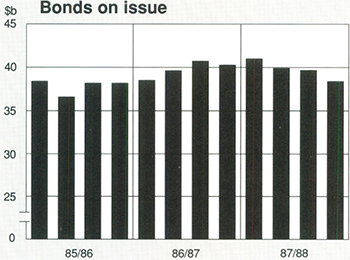Reserve Bank of Australia Annual Report – 1988 Financial Markets and the Bank's Operations[1]
There was a generally optimistic tone in Australian financial markets during most of 1987/88. The main exception was immediately following the share-market crash when sentiment was decidedly pessimistic for a while; the Australian dollar depreciated abruptly and security yields rose sharply. Patterns of financing were also changed by the crash. There was a shift away from direct financing, particularly new equity raisings which had been very high early in the year, to financing through intermediaries. Banks won business from other financial intermediaries and there was less recourse to overseas sources of funding.
Financing
The periods of confidence in financial markets were characterised by rapid growth in financing. During the early part of the year, the share market was a major source of demand for finance, not least for company take-overs and company restructuring. Equity raisings were very heavy as companies took advantage of the low cost of this type of finance. Even small companies resorted to equity markets, often through the expanding second boards. The increase in new share issues was one factor in the higher growth of credit as some investors borrowed to take up the shares available.
After the share-market crash, direct sources of financing were subdued and intermediaries dominated financing. Equity raisings were well below their levels in the middle months of 1987, despite signs of some pick-up in the final quarter of the year. Likewise, promissory note issues were small. Caution remained about the creditworthiness of some firms. Investors were more selective on ‘names’ and appeared to prefer securities with shorter terms to maturity than was the case before the share-price fall. Towards the end of the year, however, there was some sign of a revival of corporate bond issues as the Government's Budget moved into surplus.
Finance facilitated by intermediaries rose very strongly from late in 1987, with much of the increase in the form of bank bills. The majority of these bills were taken up by investors outside the financial sector, reflecting an increased preference for bank-backed assets over claims on other institutions. The use by intermediaries of overseas sources of funds to finance their lending in Australia grew relatively slowly in 1987/88 after rising sharply in recent years. Euro-Australian dollar bond issues remained an important source of funds for much of the year.
Lending for property, both commercial and residential, was strong throughout the year. In the second half of the year, housing lending accelerated. On the demand side, there was a move away from share-market investment to purchases of residential property either for owner-occupation or investment. On the supply side, savings banks, flush with funds in the months following the share-market crash, substantially increased their rate of lending. Housing prices rose at a fast pace, slowed only temporarily by unease at the time of the share-price fall.
The Bank's operations
The Bank's operations in domestic financial markets have two main objectives. One is to assist the markets to handle large short-term fluctuations in financial flows. The other, which is more important in the medium term, is to pursue the aims of monetary policy by influencing domestic financial and credit conditions.
In the early months of 1987/88, monetary conditions eased and interest rates continued the decline which had been in progress since the end of 1986. Improved economic news and indications of further fiscal tightening gave support to this trend. As the September quarter progressed, there was increasing concern about the higher levels of financing, especially for the purchase of shares and property, and the rate of growth in asset values. The Bank resisted tendencies for interest rates to fall further.
3 Interest Rates, Exchange Rates and the Bank's Foreign Exchange Transactions

4 SECURITY YIELDS

The onset of the sharp share-market fall in October raised expectations that it would remove concerns about a resurgence of inflation and any tendency for the economy to overheat. The Bank's first concern at that time was stability of the financial system, and it moved quickly to reassure market participants about the availability of system liquidity. In its transactions, the Bank allowed financial conditions to ease a little so as to avoid possible disorder.
Reflecting the negligible effect of the share crash on the pace of economic growth, credit growth quickened again late in 1987 and remained high during the first half of 1988. The Bank initially sought to restore financial conditions to about the degree of firmness existing before the crash and to hold them there. However, by April it was obvious that further tightening was required. Overnight and call rates in the short-term money markets rose, as did market yields on bank bills and other securities. By May, the higher rates were being reflected also in interest rates paid and charged by banks and other intermediaries. The tighter monetary conditions were maintained beyond the end of the financial year, heightened at times by an appreciating exchange rate.
The Bank's operations in foreign exchange markets also serve several purposes. It buys and sells foreign currency to meet the requirements of its customers, including the Commonwealth Government. It may trade one currency for another to adjust the balance of its portfolio. And it operates to test the strength of market pressures and, where appropriate, to encourage greater market stability.
For much of 1987/88, the strong Australian dollar meant that the Bank was predominantly a buyer of foreign currency in its market operations. The main exception was in late October/early November 1987. In some periods the amounts involved were relatively heavy and the Bank added substantially to its international reserves over the year (see page 25).
The effects of the Bank's foreign exchange transactions need to be allowed for in planning its domestic market operations. When the Bank buys foreign currency, it provides the community with Australian dollars in return, adding to the volume of funds available in the domestic market. To offset this, the Bank sells domestic government securities from its portfolio. The size of the Bank's foreign exchange purchases and sales in 1987/88 was, at times, a major factor in the very high level of its transactions in the official short-term money market and in the bond market. On the other hand, in the June quarter 1988 during the heavy tax collection period, purchases of foreign currency by the Bank helped offset the impact of large transfers of funds from the private sector to the Government and reduced the size of government securities purchases the Bank would otherwise have made.
In volume terms, most of the Bank's day-to-day market transactions are in government securities of less than one year with Authorised Short-term Money Market Dealers. These transactions are directed to smoothing fluctuations in flows in the cash market resulting from “lumpiness” in government payments and receipts, including the effects of new issues of government debt, and changes in the public's holdings of notes and coin. An additional factor in 1987/88 was new arrangements for collection of company and provisional tax, which altered established patterns of funds flows to the Government. The novelty of these arrangements and some uncertainties about the size of flows likely to be involved sometimes produced greater interest rate volatility than has been the case during tax periods in the past couple of years.
5 The Australian Foreign Exchange Market






Demand for short-term government securities was often very strong in 1987/88, in part because of banks' strong preference for satisfying Prime Assets Ratio and Reserve Assets Ratio requirements with holdings of short-dated rather than longer-dated government securities. Also, the Commonwealth Government's Budget, forecast initially to be close to balance and subsequently to be in surplus, led some market participants to expect a fall in yields because of a reduced supply of government securities. The Bank, not wishing to add further to these pressures, tended to make greater use of repurchase agreements rather than outright purchases of short-term government securities when alleviating temporary liquidity shortages. Outright purchases withdraw securities from the market.
The October share-price fall
The share-market collapse brought a sharp change in sentiment in financial markets and called for quick responses by the Bank in both the domestic finance markets and the foreign exchange market.
There was a sharp increase in demand for funds. Some investors were faced with a need to raise funds quickly — some for instance, to meet margin calls on futures contracts; others to cover delays in settlement of transactions. The Bank sought to steady the market and provide some reassurance both by its own transactions and by announcing that it was keeping a close watch on liquidity conditions in financial markets.
Within a few days of the initial collapse in share prices, sentiment towards the Australian dollar deteriorated sharply. There was a substantial shift of funds out of Australian-dollar assets and strong downward pressure on the exchange rate. The Bank, seeking to steady market conditions, sold more than US$1.5 billion in foreign currency over a few days. The Australian dollar depreciated in this period by US4 cents, or in trade-weighted terms by 6 per cent. Over the next few weeks, the Bank made further sales of foreign currency, although for much smaller amounts, in testing occasional bouts of downward pressure on the Australian currency. The tightening of financial conditions which would normally have flowed from central bank sales of foreign currency to the banking system was taken into account in planning domestic market operations. In brief, over this period the Bank bought Commonwealth securities to offset the effects of its sales of foreign currency.
Although conditions in financial markets remained fragile for some months, and the Bank kept in close touch with all sectors of the financial system, there was no further need for extra-ordinary responses on the Bank's part.
It is possible to identify a number of effects of the share-price fall. It did, of course, inflict substantial losses on many individuals and institutions, including financial intermediaries. Values of share portfolios were slashed, reducing investors' perceived wealth directly or through holdings in managed funds, especially equity trusts. Some brokers incurred large losses on underwriting agreements and on their own share portfolios, as well as having likely bad debts from clients. Two small brokers were suspended but otherwise, assisted by increased capital over recent years, brokers generally coped satisfactorily with the abrupt falls in market values and turnover.
Investors, seeking assurance, shifted funds accordingly. This added further to the slide in share prices. Banks were the main beneficiaries and, although they reduced their deposit interest rates, soon had a substantial increase in their deposits. Savings banks, in particular, had increased flows into investment and statement accounts. Other groups of intermediaries fared less well. Building societies held their ground while cash management trusts, credit unions and finance companies lost deposits. Intermediaries closely linked with the share market, such as equity trusts, lost funds too, after attracting large inflows in previous quarters. Within these groups, experiences of individual institutions sometimes differed widely; one savings bank had a brief run on its deposits when unfounded rumours circulated about its financial situation. Following a statement by the Bank, the outflow halted and business returned to normal.
6 Market in Bank Bills



7 MARKET IN BONDS



Government securities markets
The Commonwealth Government applied some of its overall budget surplus in 1987/88 to the repayment of $1.6 billion of overseas borrowings. This meant a correspondingly smaller reduction in its domestic indebtedness and in Commonwealth Government securities on issue in Australia. This was useful from a market viewpoint, particularly given the strong demand for Commonwealth securities. Treasury notes on issue were at much the same level at end 1987/88 as a year earlier; Treasury bond maturities exceeded new issues. Thus, total supplies available declined. Australian Savings Bonds were withdrawn from issue in September, but subscriptions still just exceeded redemptions for the whole financial year. There were again modest new issues of indexed bonds; these securities have not yet been available long enough for there to have been any maturities.
The Government's Budget surplus in 1987/88 meant that the total stock of domestic government securities fell by about $2 billion. The $3.6 billion fall in the Bank's portfolio (see below) allowed the private sector's holdings to increase by over $1.7 billion. Banks needed to increase their holdings by over $2.5 billion to maintain their minimum Prime Assets Ratio (trading banks) and Reserve Assets Ratio (savings banks) requirements. This was achieved by banks bidding securities away from non-banks whose holdings fell about $1.0 billion.
Turnover in the bond market rose strongly during the year; it was close to $2 billion a day in the June quarter, compared with around $1 billion a day in the corresponding period a year earlier.
8 Equity Markets



9 Financing



10 Deposits



Changes in the Bank's balance sheet
The Bank's total assets fell by $1.0 billion in 1987/88.
This was more than accounted for by valuation effects.
The Bank's transactions led to a marked change in the composition of its assets:
- its net purchases of foreign exchange were $3.2 billion; and
- it made net sales of government securities of $3.6 billion.
Overall, the Bank's holdings of gold and foreign exchange rose by $2.6 billion
to $19.9 billion.
Details are:
| $A billion | |
|---|---|
| • net purchases from the market | 6.9 |
| • net sales to Government | −1.7 |
| • earnings on investments | 0.7 |
| • valuation effects | −1.3 |
About 50 per cent of the Bank's holdings of foreign currency are in U.S. dollar assets. The balance is held in a range of currencies, including Japanese yen and Deutschemarks. The lower value of the Bank's holdings of gold was due entirely to movements in the Australian dollar price of gold.
Footnote
*Articles with details on the Bank's market operations are published regularly in the Bank's Bulletin. [1]